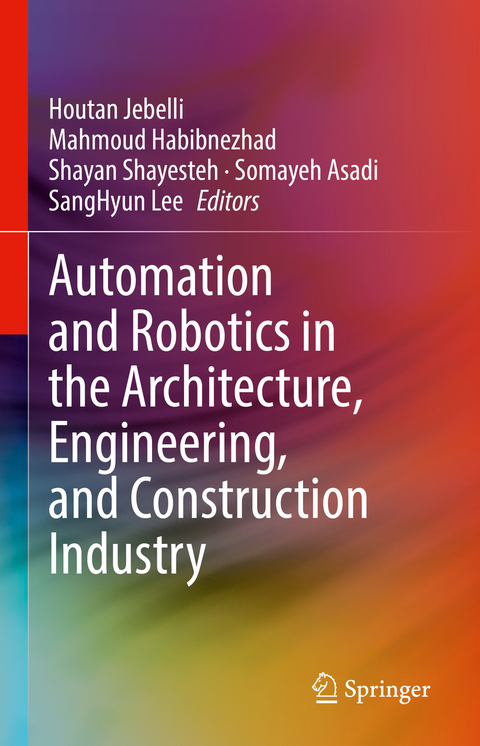
Automation and Robotics in the Architecture, Engineering, and Construction Industry
Springer International Publishing (Verlag)
978-3-030-77162-1 (ISBN)
Houtan Jebelli, Ph.D., is an Assistant Professor in the Department of Architectural Engineering and Affiliate of the Institute for Computational and Data Sciences at the Pennsylvania State University. He earned his Ph.D. in Civil Engineering from the University of Michigan. He received his bachelor's degree in Civil Engineering from Tehran Polytechnic University and an MSc in Structural Engineering from the Sharif University of Technology. Dr. Jebelli completed a second MSc in Construction Engineering and Management from the University of Nebraska-Lincoln. While pursuing his Ph.D., he received his third MSc in Electrical Engineering and Computer Science. Dr. Jebelli is Director of the Robotic, Automation, and Intelligent Sensing (RAISE) Lab. Dr. Jebelli's research group at Penn State explores novel approaches that infuse human physiology into robotic control and motion planning system to augment awareness and adaptation between workers and robots. His team's other thematic priorities involve physiological computing for construction automation and safety, physiologically-enabled health monitoring of construction workers, brain-driven approaches for teleoperation, and personalized worker-robot collaboration and co-adaptation at construction sites. He has received several awards and fellowships, including the Charles M. Eastman Top Ph.D. Paper Award, two Outstanding Thesis Awards, the Rackham Research Grant, the John L. Tishman Fellowship, and the Calvin C. Solem Foundation Fellowship. He serves as a reviewer for a number of journals and symposia and is an active member of professional communities like the ASCE Data Sensing and Analysis (DSA) and ASCE Visualization, Information Modelling, and Simulation (VIMS) committees.
Mahmoud Habibnezhad, Ph.D., is a Postdoctoral Scholar in the Department of Architectural Engineering at the Pennsylvania State University. He received his BSc in Civil Engineering and first MSc in Structural Engineering from the Sharif University of Technology. He received his second MSc in Computer Science and his Ph.D. in Construction Engineering and Management from the University of Nebraska-Lincoln. Dr. Habibnezhad's current research strives to develop convergent approaches to promoting safety and productivity at construction sites by transforming manual construction activities into semi- or fully automated operations. In the realm of human-technology interaction, his research contributes to intuitive control of human-operated assistive machines, digital twins for cyber-physical systems, and the development of safety-critical training platforms for future machinery-dominated construction sites. Dr. Habibnezhad has a successful record of publications in immersive technologies, physiological computing, computer vision, and human-robot collaboration and adaptation, all with the focus on construction safety. He also serves as a reviewer for a handful of peer-reviewed journals, including Automation in Construction, Virtual Reality and Intelligent Hardware, Applied Sciences, and Journal of Construction Engineering and Management.
Shayan Shayesteh is a Ph.D. student in the Department of Architectural Engineering at the Pennsylvania State University. He received his BSc degree in Civil Engineering from the University of Tehran in 2016. He also received his MSc degree in Construction Engineering and Management from the University of Tehran in 2019. His research focuses mainly on exploiting immersive technologies to improve worker-robot partnerships at construction sites. He explores different aspects of human-robot interaction and their impact on various human factors through the application of wearable biosensors. By overcoming the challenges ahead, he aims to develop an innovative training platform for human-robot collaboration at construction workplaces.
Somayeh Asadi, Ph.D., is an Associate Professor in the Department of
Automation and Robotics Technologies Deployment Trends in Construction.- Essential Knowledge, Skills and Abilities Required for Talent Cultivation in Construction Automation and Robotics.- Robotics and Automation in Construction (RAC): Priorities and Barriers toward Productivity Improvement in Civil Infrastructure Projects.- Construction Automation and Sustainable Development.- A Briefing on Technological, Societal, and Economical Aspects of Automation in Construction.- Human-Drone Interaction (HDI): Opportunities and Considerations in Construction.- Safety Challenges of Human-Drone Interactions on Construction Jobsites.- Assessing the Role of Wearable Robotics in the Construction Industry: Potential Safety Benefits, Opportunities and Implementation Barriers.- Fault-Tolerant Physiology-aware Signal Classification Algorithm for Robust Decisions in Perceptive Robotics Systems.- Workers' Trust in Collaborative Construction Robots: EEG-Based Trust Recognition in an Immersive Environment.- Index.
| Erscheinungsdatum | 06.01.2022 |
|---|---|
| Zusatzinfo | X, 224 p. 73 illus., 42 illus. in color. |
| Verlagsort | Cham |
| Sprache | englisch |
| Maße | 155 x 235 mm |
| Gewicht | 511 g |
| Themenwelt | Technik ► Elektrotechnik / Energietechnik |
| Technik ► Maschinenbau | |
| Weitere Fachgebiete ► Handwerk | |
| Schlagworte | automated monitoring • Automated project control • Automation • Computer-integrated construction • Construction systems • Human-Computer interaction • Human-Robot Interaction • Intelligent site mapping • Robot assembly system • Robot control algorithms • Robotic operating systems • Robotics |
| ISBN-10 | 3-030-77162-8 / 3030771628 |
| ISBN-13 | 978-3-030-77162-1 / 9783030771621 |
| Zustand | Neuware |
| Informationen gemäß Produktsicherheitsverordnung (GPSR) | |
| Haben Sie eine Frage zum Produkt? |
aus dem Bereich


